Béla Tarr's Anti-Classical Program
Family Nest (Családi tüzfészek, 1979) and Macbeth (1982)
Vol. 34 (October 2013) by Moritz Pfeifer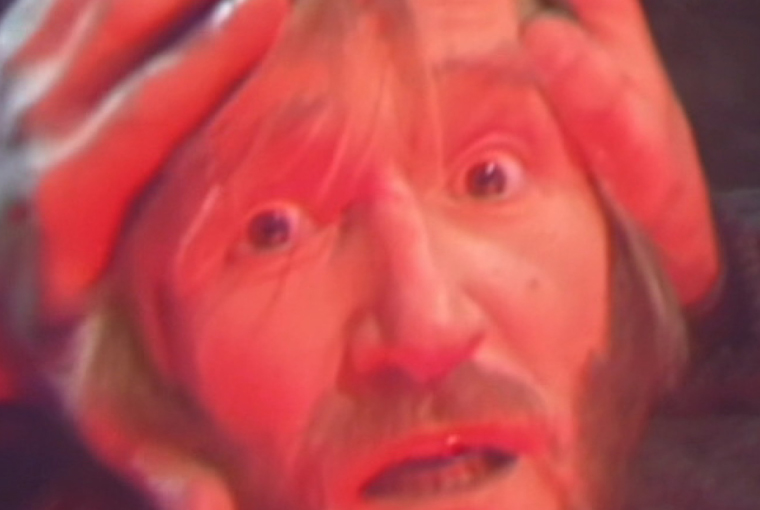
When Tarr entered film school sometime at the end of the 1970s, one of his professors urged him to try something more classical. Tarr was originally banned from higher education but after the success of his first feature film, Family Nest (1979), authorities found it adequate to send him to film school. Family Nest was perhaps not considered classical in the sense that it focused on everyday life; it meticulously captured the social disintegration of a poverty-stricken family. Compared with Family Nest, Macbeth (1982), which was Tarr’s attempt to fulfil his professor’s demands, surely looks different in every way and is now appreciated for demarcating Tarr’s “middle period” in which he switched from social to magical realism. The Shakespeare play does a lot to intensify this. In the play there are kings, not workers; a castle, not a communist housing block; witches, an ancient goddess, ghosts, delusions, and other figures, like the gatekeeper, who may or may not be from this earth.
Tarr’s version of Macbeth, accordingly, was shot in a castle in Budapest, it is colored – which may also be due to the fact that it was produced for television – , and staged. Where Family Nest used non-professional actors, Macbeth (György Cserhalmi) had already played in many movies including Istvan Szabo’s Mephisto (1981) and the lady (Erzsébet Kútvölgyi) also had a considerable filmography on her back, including a role in Pál Sandor’s A Strange Role which won the Silver Bear in 1976. Ironically though, this is really as theatrical or “classical” as it gets. In Tarr’s Macbeth fantastic elements still get reduced to a more realist program. The scenes are kept dark, costumes minimalist, and the camera is mostly tracking faces instead of decorated scenes. Tarr neither shows Banquo’s ghost nor the flying dagger. One only has to compare Polanski’s dagger-scene with Tarr’s to understand how different Tarr’s simplicity is from the flamboyance commonly associated with Shakespearean imagination:
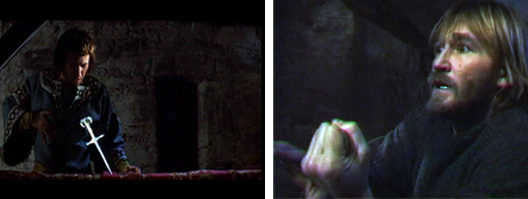 “Let me clutch thee…” as in Polanski (left; detail) and Béla Tarr (right)
“Let me clutch thee…” as in Polanski (left; detail) and Béla Tarr (right)
Although, there’s a lot of stuff in Macbeth and Shakespeare in general that could be compared to some of Tarr’s later movies, especially when it comes to holy fools and drunken prophets, Macbeth is, really, much closer to Tarr’s docudramas in terms of content and style. In the Turin Horse, Tarr’s last film, there’s the neighbor (Mihály Kormos) who, after drinking what looks like a bottle of pálinka goes on rambling about human bankruptcy and cycles of apocalypse which is pretty much how the film ends; in Damnation there is the lady in the cloakroom (Hédi Temessy) who prophesies the main character’s downfall; and in Werckmeister Harmonies there’s the drunken Hotel Clerk who predicts the town’s self-destruction and is the only one who knows the true meaning of the whale. All these figures could easily be found in Shakespeare, but his version of Macbeth lacks wise fools. Tarr even reads Banquo’s description of the three witches – “upon her skinny lips: you should be women, and yet your beards forbid me to interpret that you are so” – literally and casts them as three men.
Especially telling in comparison to Tarr’s earlier movie is the use of close ups. The camera follows faces, not events which is an especially untypical choice for a historical adaptation and one which brings Tarr’s movie closer to Family Nest than to later films. As in Family Nest, the close-ups in Macbeth draw the attention to the character’s feelings and words instead of telling his story, as he does in later films, through details of setting and scenery. Tarr avoids the play’s Elizabethan gimmicks, side-narratives and special effects to tell a pretty straightforward story about corruption and betrayal and strips the drama down to the dark relationship between Macbeth and his power-hungry wife – her efforts to seduce her husband into getting rid of (i.e. killing) everyone in his way to the throne and the poor man’s moral struggle of feeling either enticed or worried by doing this. Love relationship and close-ups are thus what connects this couple to the one in his previous film. Indeed, the conspiring father in Family Nest, who makes his son believe that his (the son’s) wife is seeing other men in order to secure his patriarchal power in his cramped house and perhaps have one person less to deal with already is “classical” tragic material.
Most importantly, the film introduces Tarr’s first Film Length Shot. Macbeth actually consists of only two shots, the first of about five minutes and the other shortly under an hour. Although this brings the film closer to Tarr’s later work, it is important to stress that the Film Length Shot in this movie is completely different from the orchestrated choreographies and landscape tracking shots of his later films. In these long takes, the scenery turns into a poetic meditation on the things that go on in the movie. In Damnation, for instance, long takes over ruinous houses and desolated streets mirror the depression of the characters. In Macbeth there is no landscape or scenery; faces and language have to do the job.
Tarr’s later long takes are now cliché. From Miklós Jancsó to Tarkovsky, from Angelopoulos to Sokurov, they represent a certain kind of meditative or spiritual filmmaking which – rightly or wrongly – is sometimes frowned upon, especially when it comes to looking at endless shots of seemingly meaningless objects and scenery. When Antonioni’s L’eclisse was screened for the first time the spectators shouted “Cut! Cut!”. But the long takes of close-ups in Macbeth have quite a different effect. They are nervous and fretful and, to be honest, I only realized that it was all one shot after quite a while. Whereas some long takes are really rather long, Tarr’s mega-long take in Macbeth is dynamic, breathless, and doesn’t serve the stereotype of the contemplative shots for which Béla Tarr and other filmmakers are now (in)famous.
Above all, Macbeth shows how much form depends on content. Filming people walking from place to place is different from showing faces in angry conversation even if both can, like Béla Tarr did, be filmed in super long takes. Similarly, there’s a difference between a super-long sentence describing the details of some scenery and a super-long sentence describing emotions. Compare, for instance, one of the super long sentences in Marcel Proust’s Swann’s Way about the narrator’s childhood chambers with one of the super long sentences in Thomas Bernhard’s Yes in which the narrator is furious that he told a friend about his sickness. Proust: “in a sort of alcove without walls, a cave of warmth dug out of the heart of the room itself, a zone of heat whose boundaries were constantly shifting and altering in temperature as gusts of air ran across them to strike freshly upon my face” and so on. Bernhard: “I was trying not only to outline to him the symptoms of my emotional and mental sickness and eventually elucidate them as a science, but had come to Moritz’s house, who in point of fact was then probably the person closest to me, in order quite suddenly and in the most ruthless manner to turn the inside of my, by then not just sickly but totally sickness-ridden, existence, which until then he had known just superficially and had not therefore been unduly irritated let alone alarmed by in any way” and so on. Proust’s passage about the children’s room is pensive or meditative and is more similar to Tarr’s later long takes. It feels long because it takes a while for the author to describe all aspects of this room whose details are important to the narrative for many reasons, one of them being that they personify some of the characters; the “warmth” of the room’s “heart” can easily stand for the affection the narrator feels for his mother. Tarr chooses a similar language in later movies, for instance, in the Turin Horse, where interior and exterior worlds overlap (the wind, which can be heard more loudly inside the house or the drying out of the well are only two examples). Bernhard’s passage about the narrator’s sickness, on the contrary, is an angry stream-of-consciousness, a run-on full of emotions. Although it is as long as the first (~500 words), it feels shorter because the author doesn’t take any time to describe anything at all except his brute feelings. It is more similar to Tarr’s early long takes in which the characters spit out whatever is on their mind in non-stop conversion. It may be for this reason that Tarr cut out most of the side-narratives in Macbeth, focusing almost exclusively on the verbal relationship between the lady and her husband.
I think this difference may be useful to understand the difference between Tarr’s earlier and later long takes. Thus it is difficult to suppose that Bélà Tarr’s anti-classical program kicks in with his super-long takes. The real shift, then, is a shift not of how things are shown, but of what is shown, namely of supplementing direct speech, close-ups, and drama with indirect speech, landscapes, and non-dramatic plots. These later, truly anti-classical, elements slowly become more important as Béla Tarr’s filmography piles up. It is almost ironic that the intrigue in Family Nest didn’t strike his professor as profoundly classical. A “Shakespearean” lady Macbeth can still be found in one of Tarr’s later films – Werckmeister Harmonies – where Tünde Eszter (Hanna Schygulla) threatens her husband to convince the people of his town to welcome the new regime or else she will return and live with him, along with her lover, the local chief of police. Classical narrative elements, like manipulation and betrayal, are present in all of his films, with the exception of Turin Horse. This is the only film that is anti-classical through and through. Only this film lacks any reference to classical drama.
Béla Tarr once claimed that not having more than 10 minutes celluloid is censorship and that using this time and, with the advent of digital filmmaking, even more, is a way of resisting a form imposed by the film industry. In one interview he says that “the people of this generation know information-cut, information-cut, information-cut. They can follow the logic of it, the logic of the story, but they don’t follow the logic of life. Because I see the story as only just a dimension of life, because we have a lot of other things. We have time, we have landscapes, we have meta-communications, all of which are not verbal information. If you watch the news it is just talking, cutting, maybe some action and afterwards talking, action, talking.” This, I believe, is already the later Tarr speaking. Society, not landscapes, and direct speech, not looks and gestures, are precisely the things which dominated Tarr’s early works, and yet he didn’t cut in these works either. Even the last shot of Family Nest runs over 5 minutes.

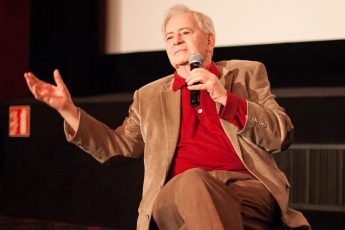
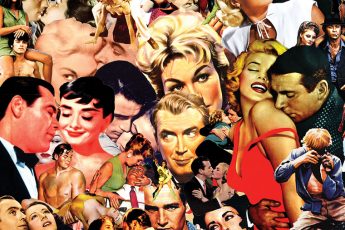
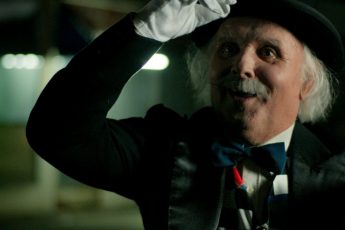
Leave a Comment